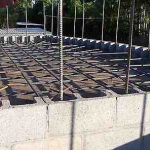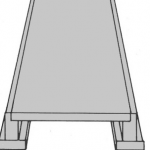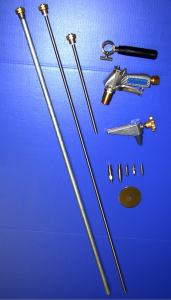I was on a termite renewal the other day of a job I did probably 6 or 7 years ago. I remember it well because I had to fight every kind of tropical plant and bush just to get close enough to the house to work. To make matters worse this was a supported slab construction and the grade went from about 3 inches below the slab on the front side of the home to about 3 feet on the back. Being a supported slab means that the top block of the foundation is what they call a ‘chair’ block and when the cement floor is poured it ‘sits’ on that block and an expansion joint often forms as the slab dries and can separate from the tall back end of the block. In other words this is what we call a full drill job because to access this entry point you have to drill through the block entirely to get to the dirt and entry points soil on the other side. This is very labor intensive under the best of circumstances so adding a tropical forest to the mix made it a very memorable job.
Classic termite entry points that can require long rodding
The home had two other features against it which are classic areas to get termites. It had a dirt filled attached porch on the back side of the home as well as a ‘frame’ bay window also on the back side. Both slabs were at least 3 feet above grade so that means they were sitting on 3 feet of fill dirt. The problem with dirt filled porches is in their name- DIRT FILLED. That’s where termites live and move with ease so having a porch slab with 4 walls on top of a mound of the stuff makes it unlikely that termites would pass up the chance to at least  explore the area looking for wood to eat. Also where the porch slab meets the home our good friend the expansion joint can and often does form which gives the termites a very secretive way in which to enter the home undetected. Treating a dirt filled porch can be a challenge because you need to get your liquid to the under side of the porch slab to protect that area so normally you drill down through the slab but there are times (and this was one of them) when this is not desirable. In todays homes it’s common for people have expensive tiles or wooden floor covering and putting a hammer drill to such surfaces can cause unsightly marring. So to treat you need to drill through the side walls from the exterior on each side parallel to the home. Then inserting a very long treatment rod you can reach from the sides to get under what you could not access from the top, this is called long rodding.
explore the area looking for wood to eat. Also where the porch slab meets the home our good friend the expansion joint can and often does form which gives the termites a very secretive way in which to enter the home undetected. Treating a dirt filled porch can be a challenge because you need to get your liquid to the under side of the porch slab to protect that area so normally you drill down through the slab but there are times (and this was one of them) when this is not desirable. In todays homes it’s common for people have expensive tiles or wooden floor covering and putting a hammer drill to such surfaces can cause unsightly marring. So to treat you need to drill through the side walls from the exterior on each side parallel to the home. Then inserting a very long treatment rod you can reach from the sides to get under what you could not access from the top, this is called long rodding.
Bay windows are also a classic termite trap because contractors predominately make them with wood even if the rest of the home is block construction. This bay window was also dirt filled so it posed much of the same problem. Add to both of these trouble spots a thick wall of plants that you can barely fight through and the chances of being very accurate with a 6 or 8 foot extension rod goes way down.
This winter was one of the coldest on record in Florida and it wreaked havoc on our tropical plants. Plants that could stand a day or two of freezing temps had no chance this year as we had night time temps reach that critical point for a week or more several times. The freeze  hit this house hard and what was once a house engulfed in vegetation now had hardly a green blade of grass around it. This made my inspection so much easier and I sort of wished I had just gotten the job that day. Walking around I could see all my cement drill marks in each cell of the hollow blocks and I quietly patted myself on the back for hitting my mark especially after having so much to fight through. When I came to the porch and bay window the marks stopped and the homeowner who followed me was puzzled and asked why the drill marks did not go all the way around. I reminded him of the tiled floor on the porch which would have been damaged and that the bay window which had a massive impenetrable plant in front of it. He sort of smiled and I think he was a bit embarrassed I guess for all the plants but also impressed somewhat of the technique I used to work around these obstacles.
hit this house hard and what was once a house engulfed in vegetation now had hardly a green blade of grass around it. This made my inspection so much easier and I sort of wished I had just gotten the job that day. Walking around I could see all my cement drill marks in each cell of the hollow blocks and I quietly patted myself on the back for hitting my mark especially after having so much to fight through. When I came to the porch and bay window the marks stopped and the homeowner who followed me was puzzled and asked why the drill marks did not go all the way around. I reminded him of the tiled floor on the porch which would have been damaged and that the bay window which had a massive impenetrable plant in front of it. He sort of smiled and I think he was a bit embarrassed I guess for all the plants but also impressed somewhat of the technique I used to work around these obstacles.
Long rodding is not something a termite tech does everyday and to be honest I’m not sure anybodies doing it anymore at all. I do plenty of inspections for real estate and see drill marks all the time. If you know what to look for, drill marks can tell the story of the termite history in the home and you can actually see the homes that companies have struggled with and the one that the termites came back on year after year. The one thing that my renewal made me realize is that I’m not seeing things like long rodding, bath traps, block drilling or even the use of foams much anymore for termite jobs. I posed a question in an earlier article about Termidor termiticide and if was making our job too easy and perhaps we are forgetting the basics. Whether this is true or not or if it’s widespread beyond my little view of the world I do not know. Regardless, I think knowing the many techniques is kinda like parallel parking. It’s a skill you have to master to at least pass your driving test but something (unless you live in the city) that you rarely have to use but at least knowing it and the principles behind it will ensure better termite work for our customers in case the need ever arises.
struggled with and the one that the termites came back on year after year. The one thing that my renewal made me realize is that I’m not seeing things like long rodding, bath traps, block drilling or even the use of foams much anymore for termite jobs. I posed a question in an earlier article about Termidor termiticide and if was making our job too easy and perhaps we are forgetting the basics. Whether this is true or not or if it’s widespread beyond my little view of the world I do not know. Regardless, I think knowing the many techniques is kinda like parallel parking. It’s a skill you have to master to at least pass your driving test but something (unless you live in the city) that you rarely have to use but at least knowing it and the principles behind it will ensure better termite work for our customers in case the need ever arises.




